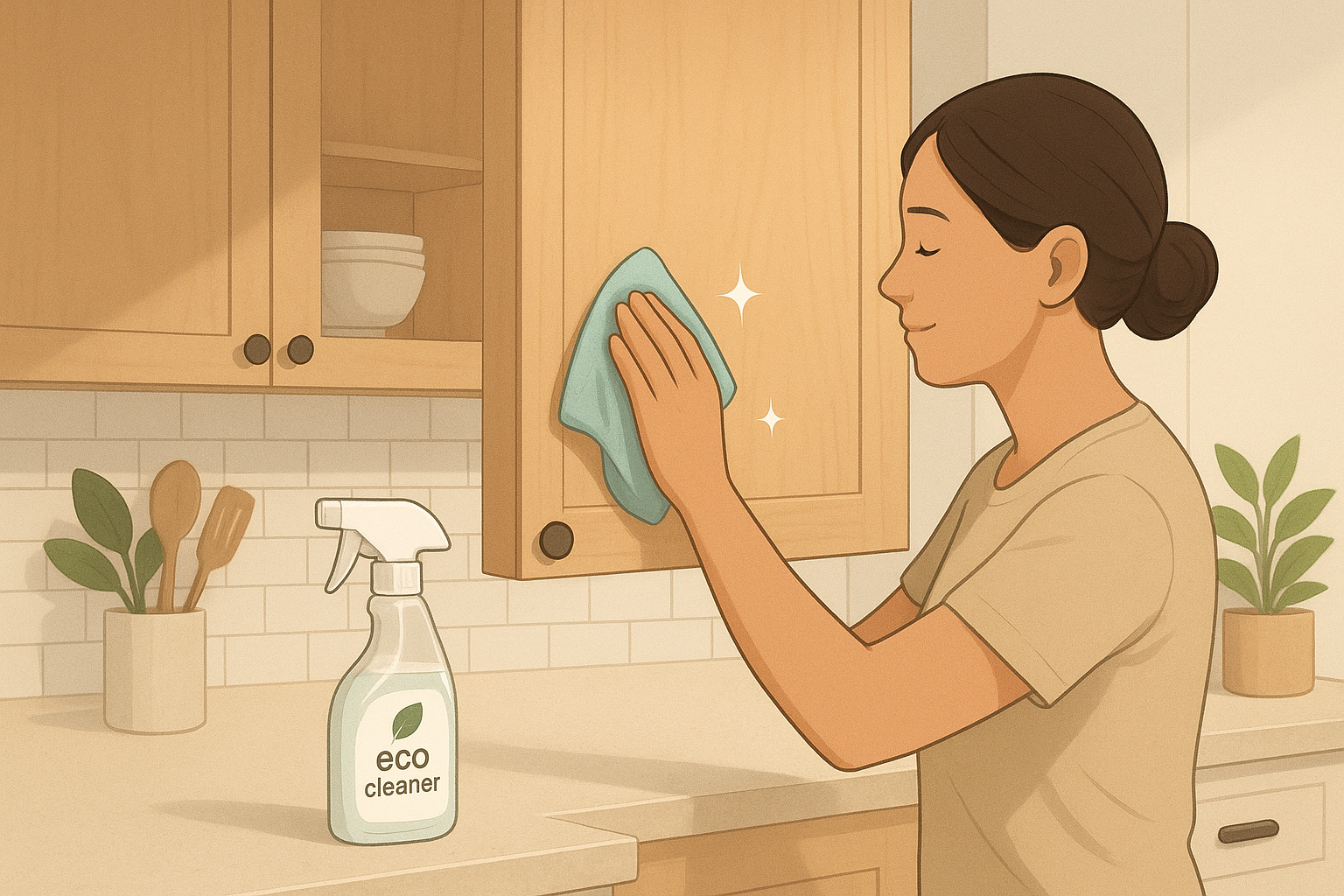Introduction
Your kitchen cabinets are the unsung heroes of your cooking space — constantly in use and exposed to grease, steam, and fingerprints. Over time, they can become dull or sticky if not cleaned properly. Knowing how to clean kitchen cabinets the right way can restore their shine, extend their lifespan, and keep your kitchen hygienic.
In this complete guide, we’ll walk you through safe cleaning methods for all cabinet types — wood, laminate, painted, or metal — using both natural and store-bought cleaners. You’ll also learn how to deep clean greasy cabinets, prevent buildup, and maintain their finish for years to come.
(Interlink: How to Paint Kitchen Cabinets — If your cabinets need more than cleaning, a quick paint refresh can transform your kitchen.)
Why Cleaning Kitchen Cabinets Matters
Kitchen cabinets aren’t just aesthetic—they also protect your utensils and food items. Without regular cleaning, grease particles from cooking combine with dust, forming a sticky film that’s hard to remove. Over time, this buildup can:
- Dull finishes and discolor surfaces
- Harbor bacteria and mold in damp areas
- Damage wood or laminate materials
- Create unpleasant odors
A consistent cleaning routine helps preserve both appearance and hygiene, keeping your kitchen fresh and functional.
Step-by-Step: How to Clean Kitchen Cabinets Properly
1. Empty the Cabinets
Start by removing all dishes, food, and utensils. This gives you full access to every corner and prevents cleaner residue from contaminating your items.
Tip: Use this opportunity to declutter—discard expired foods or unused items.
2. Choose the Right Cleaner
Different cabinet materials require different cleaning solutions:
- Wood cabinets: Mix mild dish soap with warm water, or use a vinegar-water solution (1:1 ratio). Avoid harsh chemicals that strip finish.
- Laminate or painted cabinets: A gentle multipurpose cleaner or baking soda paste works great.
- Metal or glass cabinets: Use glass cleaner or diluted vinegar for streak-free shine.
3. Wipe Down Exterior Surfaces
Dip a soft cloth or sponge into your cleaner and wring it out until slightly damp. Gently scrub doors, handles, and edges — focusing on areas near the stove where grease accumulates most.
For stubborn spots, apply baking soda paste (baking soda + water) and let it sit for 10 minutes before wiping.
4. Clean the Interior
Inside shelves can collect crumbs and dust over time. Wipe them down with a mild soapy solution and dry with a microfiber towel. For sticky residue, sprinkle baking soda, let it rest for a few minutes, and wipe clean.
5. Degrease Handles and Hinges
Cabinet hardware is often overlooked but collects the most grime. Use an old toothbrush dipped in soapy water to scrub hinges, knobs, and pulls. Rinse and dry thoroughly to prevent rust.
6. Dry Completely
Moisture is the enemy of most cabinet materials. Always dry surfaces immediately after cleaning to prevent warping or bubbling. Use a clean, absorbent towel or microfiber cloth.
7. Apply Wood Polish (Optional)
For wood cabinets, a small amount of mineral oil or beeswax polish can restore shine and protect against future stains. Apply using a soft cloth and buff gently.
Natural Cleaning Remedies for Eco-Friendly Homes
If you prefer avoiding harsh chemicals, try these natural alternatives:
- Vinegar + Water (1:1) – Removes grease and disinfects surfaces
- Baking Soda Paste – Works for tough grime
- Lemon Juice – Adds shine and neutralizes odors
- Castile Soap + Warm Water – Gentle and plant-based
(Interlink: How to Get Rid of Ants in Kitchen — Clean cabinets can also help deter ants and other pests naturally.)
How Often Should You Clean Kitchen Cabinets?
- Light cleaning: Once a week — wipe down handles and visible grease spots.
- Deep cleaning: Every 2–3 months — empty cabinets, clean interiors, and polish exteriors.
- Post-renovation or painting: Wait until surfaces are fully cured before cleaning.
Common Mistakes to Avoid
- Using too much water – Excess moisture can warp wood and damage finishes.
- Skipping test spots – Always test cleaners in an unseen area first.
- Using abrasive pads – They can scratch paint or laminate.
- Ignoring the top of cabinets – This area gathers dust and grease easily.
Maintenance Tips for Long-Term Cleanliness
- Install range hoods or exhaust fans to reduce grease buildup.
- Wipe spills immediately to prevent staining.
- Add shelf liners to protect interiors from crumbs and spills.
- Regularly polish wood to keep it sealed and resistant to dirt.
Conclusion
Learning how to clean kitchen cabinets effectively keeps your cooking space both beautiful and sanitary. Whether you use eco-friendly solutions or specialized cleaners, a little consistency goes a long way toward preserving your kitchen’s appearance and hygiene.
Clean, well-maintained cabinets don’t just look better — they make your kitchen a more inviting place to cook and gather.











